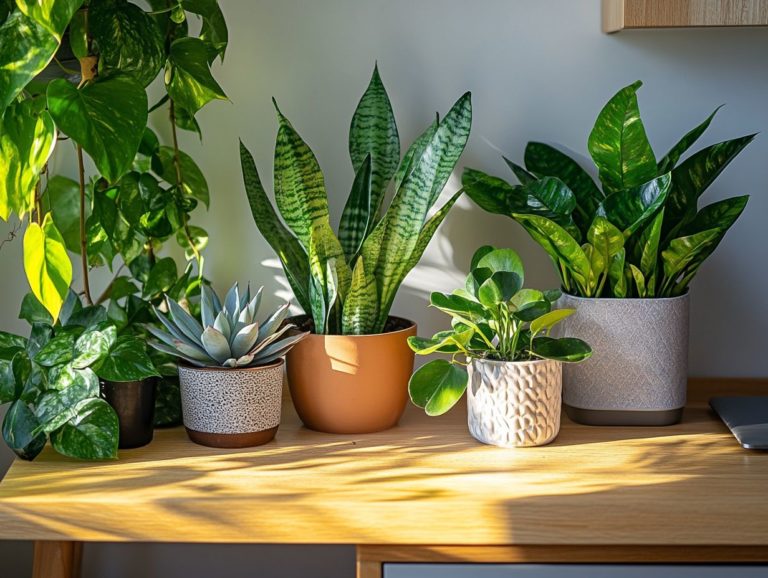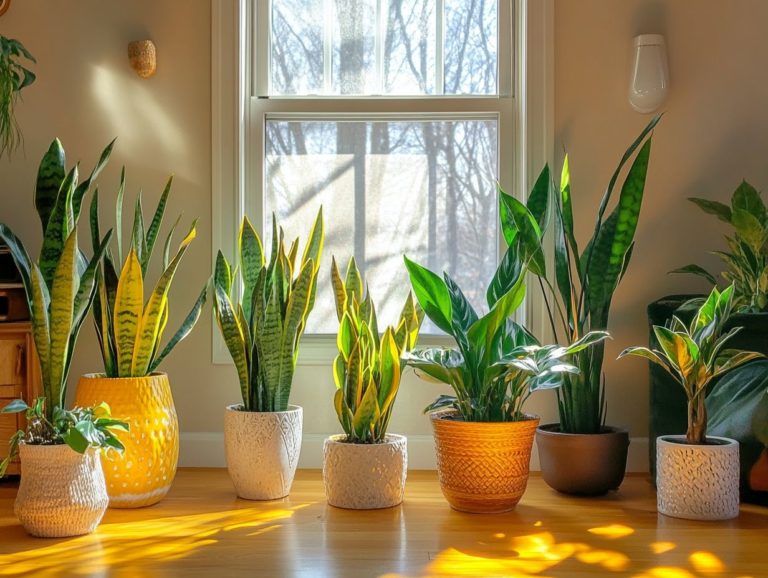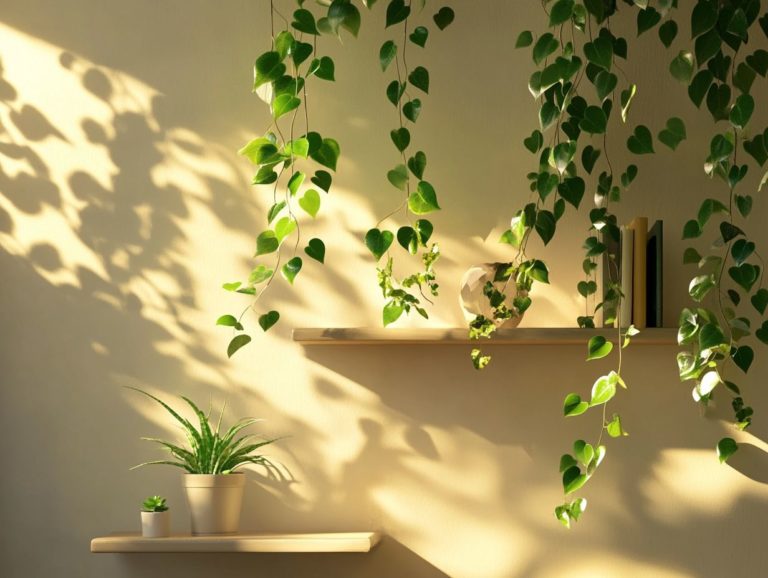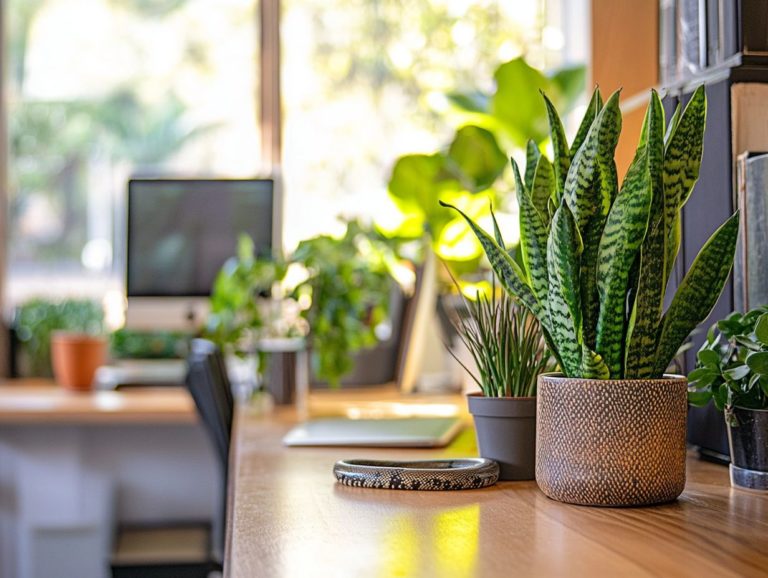How to Grow Indoor Lavender Successfully
Growing lavender indoors can elevate your living space into a fragrant sanctuary, all while providing an array of benefits.
This guide will equip you with everything you need to know, from selecting the ideal variety to crafting the perfect growing environment.
You ll uncover step-by-step instructions for planting and nurturing your lavender. You ll also find helpful tips for harvesting and incorporating it into your home!
Common issues will be addressed, and you ll receive maintenance strategies to ensure your lavender flourishes for years to come.
Immerse yourself in this journey to successfully cultivate this beautiful herb!
Contents
Key Takeaways:
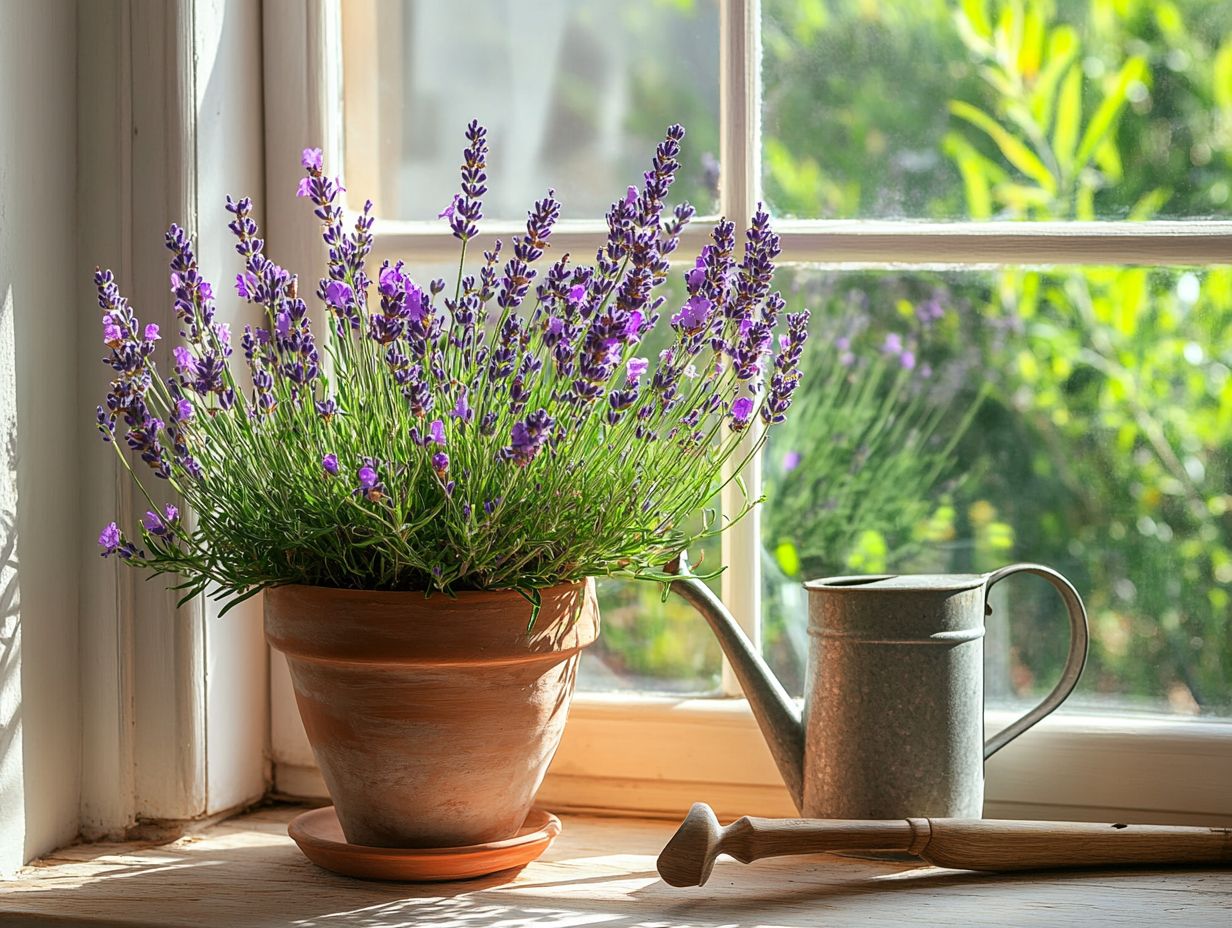
- Choose factors like sunlight and space when selecting the right lavender variety for indoor growing.
- Create an ideal environment for indoor lavender by providing adequate light, temperature, and humidity levels.
- Ensure long-term success by properly planting, caring for, and harvesting your indoor lavender plants. Troubleshoot common issues that may arise.
Benefits of Growing Lavender Indoors
Growing lavender indoors offers an array of benefits that can elevate both your living space and your overall well-being.
Imagine having a fragrant herb at your fingertips! It’s perfect for enhancing recipes and making your own lavender essential oil.
Cultivating this charming plant can transform your indoor environment. Lavender acts as a natural air purifier, uplifting your mood with its delightful aroma truly a worthwhile addition to any home.
Plus, it serves as a stunning decoration, breathing life into your indoor gardening efforts. You can enjoy its enchanting blooms, regardless of how much outdoor space you have.
The vibrant purple hues of lavender not only enhance visual appeal but also create a soothing atmosphere, ideal for your relaxation zones.
If you have a passion for culinary arts, you ll appreciate how this versatile herb can elevate dishes from salads to desserts, adding a unique twist to your everyday meals.
In terms of aromatherapy, lavender essential oil can help reduce stress and promote restful sleep, making it an essential companion for your indoor gardening endeavors.
Ultimately, growing lavender isn’t just about nurturing a plant it’s about enhancing your life in delightful ways!
Choosing the Right Lavender Variety
Choosing the right lavender variety is essential for your indoor gardening success. Consider factors like size, fragrance, and how well each type adapts to indoor conditions.
Varieties such as English Lavender (Lavandula angustifolia) and French lavender are excellent choices for indoor growth, thriving comfortably in smaller pots. If space is at a premium, dwarf varieties smaller plants that grow well in limited spaces can be a perfect solution.
By evaluating the unique attributes of each lavender type such as their delightful aromas and blooming characteristics you can select the perfect fit that aligns with your home and personal tastes.
Factors to Consider
When selecting a lavender variety, consider the specific growing conditions that will allow your plants to thrive. It s crucial to think about the light location, which should ideally be a south-facing window.
Also, monitor the temperature and humidity levels that lavender needs. Understanding how to care for your lavender means knowing how often to water and recognizing the soil’s texture to determine when it s time to hydrate.
Lavender flourishes best in full sunlight, requiring at least six to eight hours of direct light each day to truly thrive. The ideal temperature range for this aromatic herb typically hovers between 60 F to 75 F; excessive heat or cold can stress the plant.
When maintaining optimal moisture levels, check the soil s consistency. Allowing it to dry out between watering sessions promotes robust root development.
Striking this delicate balance of light, temperature, and attentive watering will create the perfect conditions for lush, fragrant blooms that elevate your indoor garden.
Creating the Ideal Growing Environment
Creating the perfect indoor environment for lavender is key to enjoying its health benefits and vibrant blooms. You ll want a well-drained potting mix and consistent access to direct sunlight, as lavender truly flourishes in bright conditions.
Choosing the right potting soil is essential; it should support drainage to prevent root rot which is when plants’ roots decay due to too much water while still retaining adequate moisture. Adjusting temperature and humidity can significantly impact the success of your indoor lavender garden. Understanding these specific needs will help your lavender thrive beautifully.
Light, Temperature, and Humidity Requirements
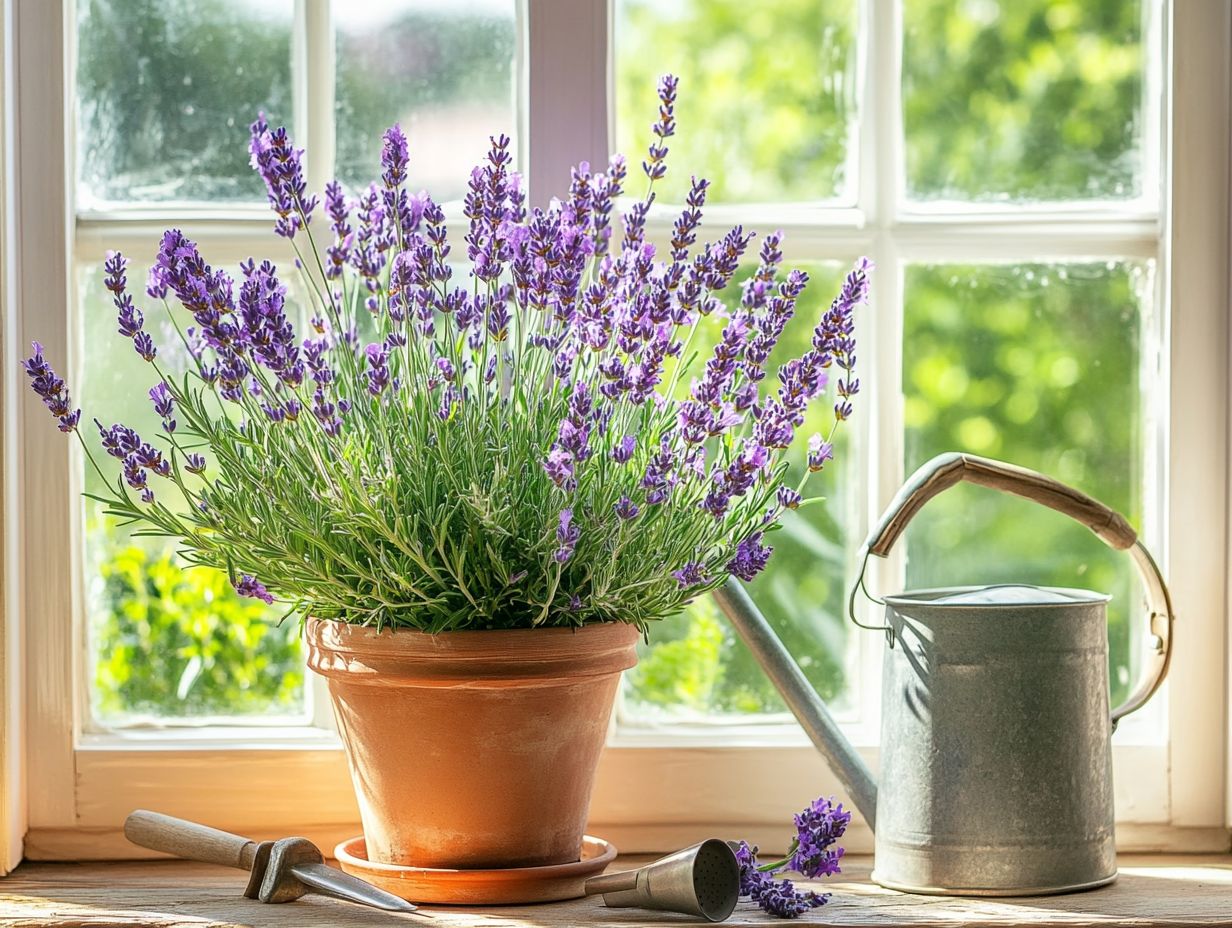
Understanding the light, temperature, and humidity requirements of lavender is essential for your indoor gardening success.
When you cultivate this fragrant herb indoors, it demands careful attention to its environmental conditions. Lavender thrives when it’s positioned in a spot drenched in natural light—think south-facing windows where sunlight streams in all day long. To create the perfect microclimate, keep your indoor space at temperatures between 65 F and 75 F, as fluctuating temperatures could stunt its growth. While some plants bask in humidity, lavender prefers low humidity levels to truly flourish. If you’re also interested in growing fruits, you might want to explore how to grow indoor strawberries successfully.
Neglecting these crucial factors can lead to lackluster growth, an increased risk of diseases, and unwelcome decay. Make sure to create these perfect conditions for thriving lavender.
Planting and Caring for Indoor Lavender
Planting and nurturing indoor lavender involves a few essential steps to ensure it flourishes in your home environment. Start by selecting young potted lavender plants that are well-suited for indoor growth.
It’s vital to use high-quality potting soil that ensures proper drainage. When transplanting your lavender, choose a pot that allows for growth without being excessively large, as an oversized pot can lead to complications like root rot.
Consistent care such as appropriate watering and regular pruning will foster the healthy growth of your lavender plants indoors.
Step-by-Step Guide
A step-by-step guide to planting and caring for lavender can transform your indoor gardening experience into a seamless success. Start by selecting healthy plants, and if you’re feeling adventurous, use propagation cuttings to expand your lavender collection. When it s time to repot, do so as needed, using fresh potting soil to encourage those stunning lavender blooms.
Watch your plants for any signs of distress; don’t wait too long to act if you notice any issues. By embracing a structured approach, anyone can cultivate beautiful lavender that flourishes indoors. Begin by choosing a pot with good drainage holes; excess water is a one-way ticket to root rot. If you’re interested in expanding your indoor garden, consider learning how to propagate herbs indoors.
Once your pot is ready, mix a soil blend specifically designed for drought-tolerant plants, adding sand to improve drainage. Watering should be minimal yet consistent; allow the soil to dry out between sessions to avoid the perils of overwatering. As your lavender matures, timely pruning will improve air circulation and stimulate new growth, maximizing the potential for lush, aromatic blooms. Remember, placing your lavender in a spot where it can soak up ample sunlight is vital for its overall health and prosperity.
Harvesting and Using Lavender
Harvesting and utilizing lavender is a truly enriching experience that elevates your cooking, enhances your well-being, and transforms your home s atmosphere.
To capture the maximum potency of lavender essential oil, it’s essential to time your harvest when the flower stems are in full bloom. Once you’ve gathered the blooms, you can incorporate lavender into a variety of flavor profiles, bringing a distinctive twist to your culinary creations.
Alternatively, you might choose to dry the flowers for potpourri or sachets, infusing your space with their delightful fragrance. By grasping the myriad uses of lavender, you’ll cultivate a deeper appreciation for this aromatic herb in your home.
Start your indoor lavender garden today!
Methods for Harvesting and Drying Lavender
Harvesting and drying lavender can be an elegant endeavor if approached with care. This ensures that you preserve the plant’s aromatic splendor.
Cut the lavender flower stems just before they fully open. This timing is key for optimal essential oil retention.
After cutting, gather the stems into small bunches and hang them upside down in a cool, dark place to dry. This process typically takes about two weeks.
Well-dried lavender can be stored for long-term use, whether for flavoring recipes or enriching your aromatherapy practices.
Timing is essential; late morning is the perfect window for harvesting. This helps safeguard those potent oils during the drying phase.
Once the lavender is completely dried, store it in airtight containers. Keep them shielded from light and moisture.
This careful method ensures that the fragrance and efficacy remain intact. Your attention to detail allows you to enjoy the aromatic benefits.
These techniques enhance the shelf life and elevate the quality of your lavender harvest.
Ways to Use Lavender in the Home
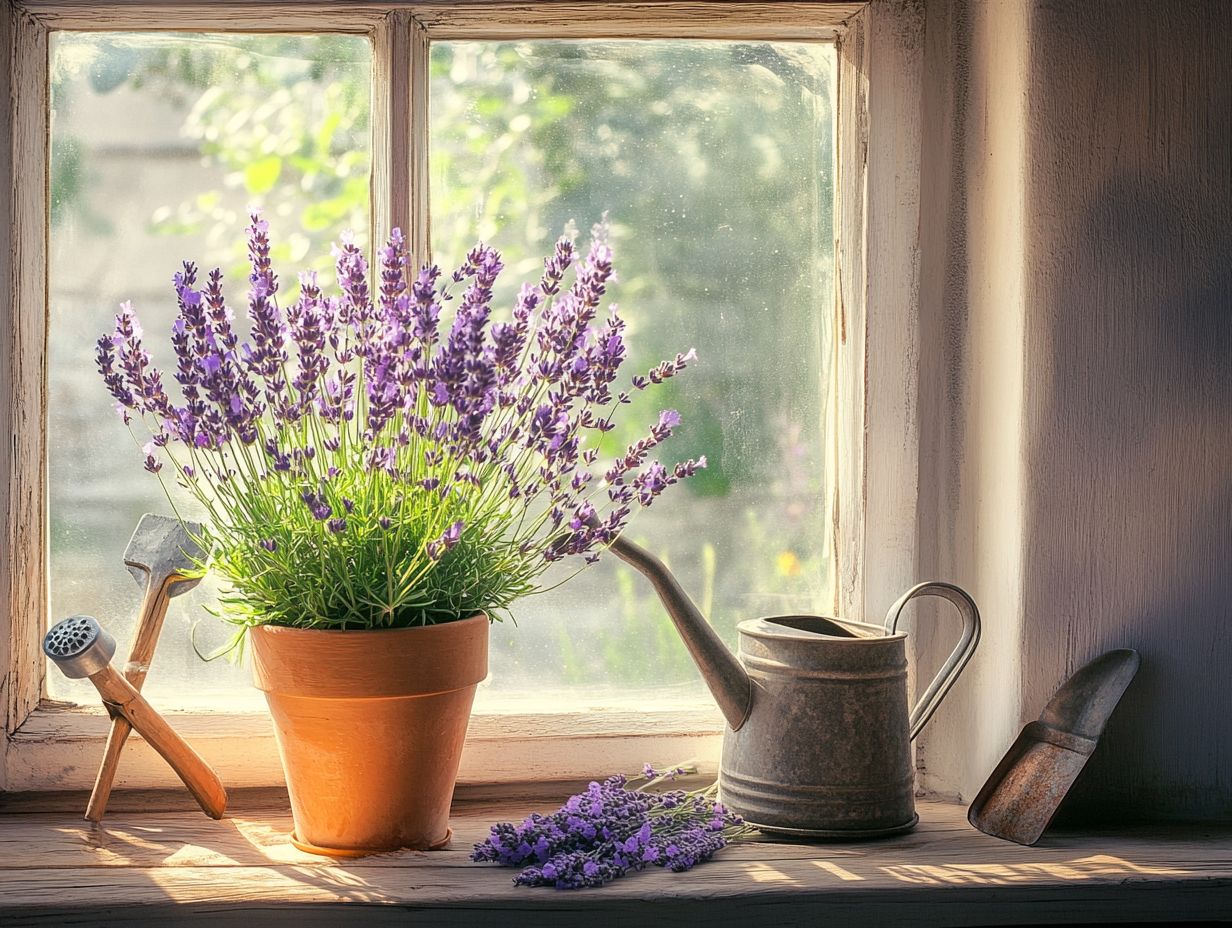
There are countless ways to incorporate lavender into your home. This herb showcases remarkable versatility.
Craft delightful lavender sachets or infuse its essence into your favorite recipes. It seamlessly transitions between culinary and aromatic realms.
You can use lavender essential oils in diffusers or add them to homemade cleaning products. This fills your space with a calming, inviting aroma.
In the kitchen, its distinctive floral notes elevate salads, desserts, and even savory dishes. Lavender provides an unexpected twist to classic recipes.
It also adds visual appeal. Picture elegant arrangements in vases or charming potpourri that enhances your home s decor.
With its relaxing properties, lavender becomes essential for your bedtime rituals. Use it in a soothing pillow spray or a calming bath infusion.
A sprinkle of this herb enhances flavors and enriches the atmosphere, transforming your home into a serene sanctuary.
Troubleshooting Common Issues
Troubleshooting common issues with indoor lavender is key to ensuring a thriving plant. Be aware that pests like spider mites, scale insects, and mealybugs can threaten your lavender’s well-being.
Neglecting proper watering can lead to root rot. Regularly inspect the flower stems and leaves for any signs of distress.
Identifying and Treating Pests and Diseases
Identifying and treating pests and diseases in your lavender is crucial for keeping your plants healthy. Spider mites, scale insects, and mealybugs can cause stunted growth and faded blooms.
Use organic insecticides or introduce beneficial insects to control these pests effectively. Regular monitoring helps you stay ahead of infestations.
Spot spider mites by their fine webbing and the stippling damage on leaves. Scale insects appear as small, brown, raised spots.
Timely treatments with neem oil or insecticidal soap can significantly reduce their impact. Stay vigilant against diseases like root rot, which shows up as wilting or yellowing leaves due to overwatering.
Ensure well-drained soil and choose disease-resistant varieties. This helps your lavender thrive and beautifies your garden or indoor space.
Tips for Long-Term Success
Implementing thoughtful strategies paves the way for long-term success in indoor lavender gardening.
This creates an ideal environment for this fragrant herb.
Establishing regular care routines, like proper watering and fertilization, is essential for nurturing healthy lavender plants.
Using propagation cuttings helps you expand your lavender collection. This promotes a cycle of continuous growth.
By remaining attentive to the conditions within your indoor gardening space, you can cultivate a flourishing lavender garden that thrives beautifully for years to come.
How to Maintain and Propagate Your Lavender
Exciting maintenance and propagation techniques can boost the longevity and productivity of your lavender plants!
Carefully selecting the right time for propagation typically in late spring increases your chances of success with those cuttings.
Taking healthy stems without flowers and placing them in a well-draining soil mix creates the perfect environment for root development.
With the right lavender care, including plenty of sunlight and minimal water, you ll support robust growth.
Regularly assessing their needs and repotting your lavender into appropriately sized pots prevents root binding and invigorates the plants.
They thrive in spacious conditions, leading to a more flourishing and aromatic indoor garden that you can truly enjoy.
Frequently Asked Questions

How do I choose the right type of lavender for growing indoors?
To successfully grow indoor lavender, it is important to choose the right type. Look for varieties that are suitable for container gardening and are known for their compact growth.
Lavandula angustifolia and Lavandula angustifolia ‘Hidcote’ are good choices for indoor growing.
What type of containers should I use for growing indoor lavender?
The best containers for indoor lavender are those with good drainage and sufficient space for the roots to grow.
Terra cotta or unglazed ceramic pots are ideal as they allow for proper airflow and prevent water from accumulating at the roots.
Make sure the pot has a drainage hole at the bottom.
How often should I water indoor lavender?
Lavender plants do not like to be overwatered, so it is important to water them sparingly to avoid root rot.
Check the top inch of soil and water only when it feels dry to the touch. Generally, watering once a week is sufficient, but it may vary depending on the humidity and temperature of the room.
What type of soil should I use for indoor lavender?
Lavender plants prefer well-draining soil with a slightly alkaline pH.
A good mix for indoor lavender is equal parts potting soil, perlite, and sand.
Avoid using regular garden soil as it may contain pests or diseases that could harm your plant.
How much sunlight does indoor lavender need?
Lavender plants thrive in full sunlight, so it is important to place them near a south-facing window or under grow lights.
They need at least 6-8 hours of sunlight daily to grow and bloom successfully.
If you notice your plant leaning towards one side, rotate it every few days to ensure even sunlight exposure.
How do I prune indoor lavender?
To keep your indoor lavender healthy and promote bushier growth, it is important to prune it regularly.
Use clean pruning shears to remove any dead or damaged leaves, and trim back the plant after it has finished blooming.
You can also pinch off any growing tips to encourage lateral growth.
Avoid cutting into the woody stems as this may harm the plant.
Ready to grow your indoor lavender? Get started today!

